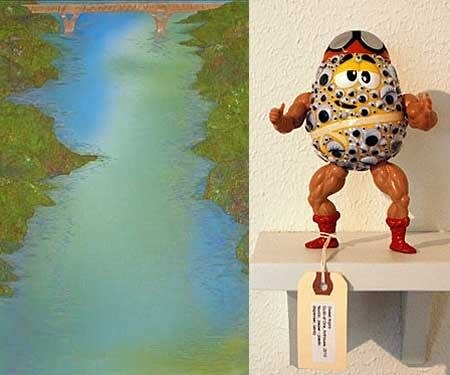City art, country art?

[image]
Two Minnesota artists, side by side: Deborah Foutch works in a studio in Minneapolis, and created the silk and cotton riverscape on the left. Karl Unnasch, who lives and works in Chatfield, Minnesota created the re-contextualized M&M dispenser/He-Man on the right.
Can you tell by looking at a work of art whether it was made by someone living in the city, or in the country? Is work done in the quiet of nature intrinsically different than work made in a highly urban environment?
A colleague posed me this question, and - while my gut instinct said "don't stereotype!" - I decided to at least put the question to artists living in both rural and urban settings, and see what they had say. The responses were intriguing.
Create a More Connected Minnesota
MPR News is your trusted resource for the news you need. With your support, MPR News brings accessible, courageous journalism and authentic conversation to everyone - free of paywalls and barriers. Your gift makes a difference.
Karl Unnasch works in Chatfield, home to about 2500 people:
Hmmmm...I don't think I could readily tell. It would take a clinical case study view to pursue this one. I can only say that the act of making art in a rural/country setting (from my comparative viewpoint) is the best way to exact focus without active and standard "urban" distractions. Moreso, I have no phone service and slow internet, so the most tempting distractions that exist for me are tending my acreage or stepping down the road to go fishing...
Megan Vossler, who teaches drawing at Macalester answered with a simple and resounding "Nope!"
Architect Jeffrey Scherer lives and works in Golden Valley. He suggests it has more to do isolation:
For me, it is more a matter of eliminating distractions in order to focus and reflect. While on the surface this may be easier in the country, I find it is not always the case. If one's power of focus is "intrinsically" sharper in the country setting, then I do believe the art work will reflect this state of mind. Generally I would venture to guess that there are "country" and "city" artists whose work could only be superficially compared.
St. Paul artist and teacher Felice Amato says it doesn't matter how much nature surrounds you if you're not paying attention to it:
I had to fight with my HS students when we drew outside a few weeks back to leave the ipods inside... I tried to explain that there was a sensory experience that would make their work different if they full experience including the sounds. I wonder if artists who grew up under the BIG SKY of the prairie express space differently than those who grew up in the shelter of woods.
Meanwhile, longtime photographer and art professor at Saint Cloud State University Ted Sherarts battles with his own perception of "craft" vs. "fine art:"
From here, it appears that the more craft-oriented artists, i.e. weavers, potters, metalsmiths, etc., tend to work in rural settings while painters, sculptors, and intermedia artist tend to be more comfortable in metropolitan surroundings. I'm suggesting a division between so-called crafts and fine arts, a division I don't like, but if one can accepts it just for discussion sake, craft artists tend to be more interested in carrying on traditions, with special attention to their materialls and tools, while fine artists prefer to carry on dialectical dialogues with history. I think my modernist leanings are showing!
And finally, Minneapolis sculptor has this to say about our own expectations:
I think there's a bias towards realism in the country vs in the city. In the city, there's an overly cerebral aspect of art that happens in the city. I think it's really all about mind set. What people think they should make compared to their relative culture vs not caring what their culture advocates.
So do you think there are differences between urban and rural art? Or urban and rural artists? Let us know!